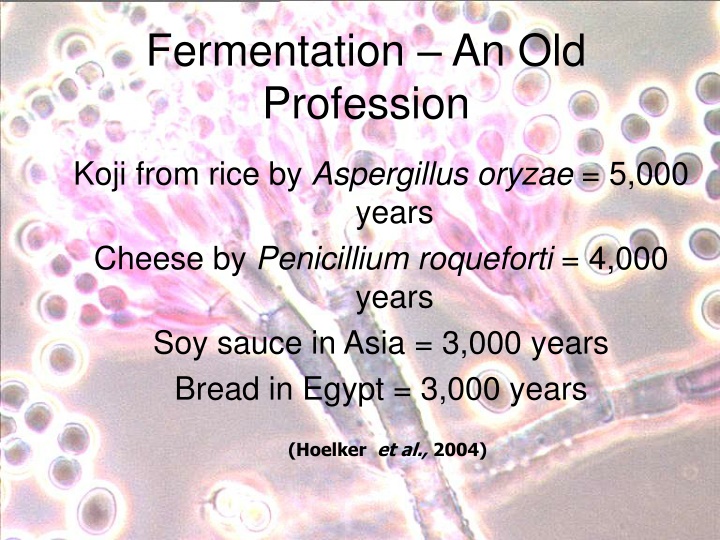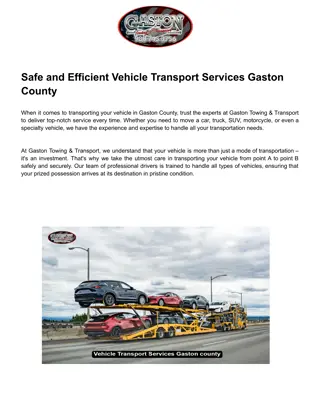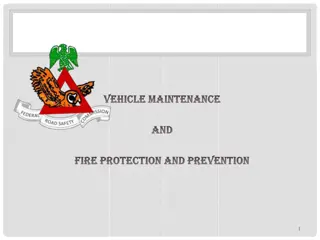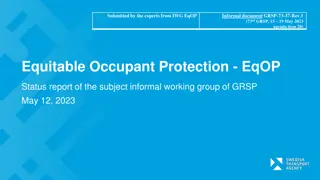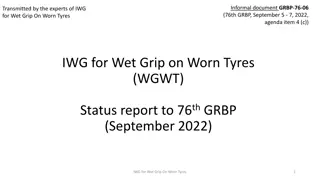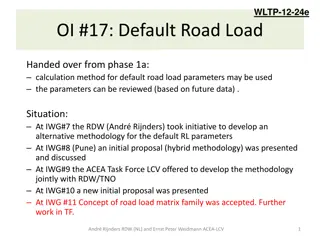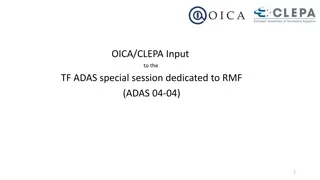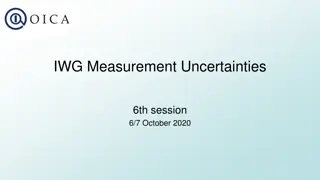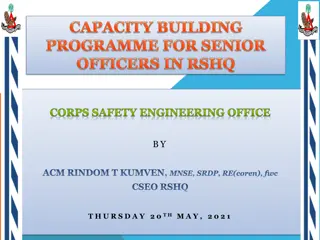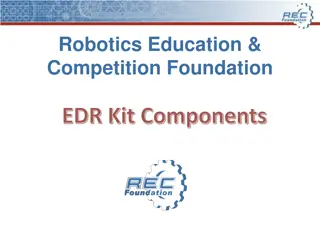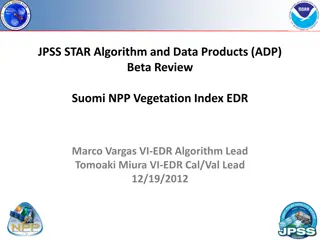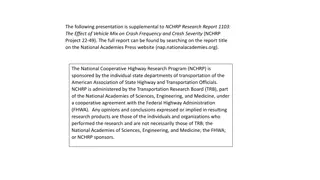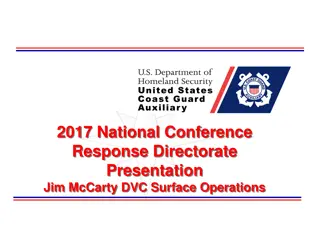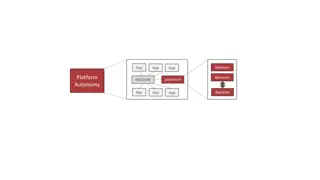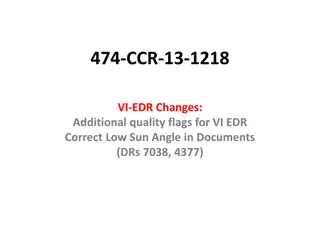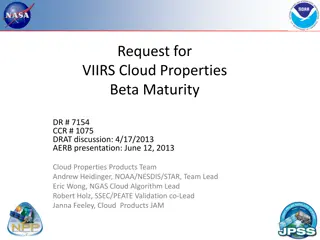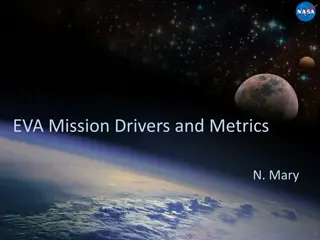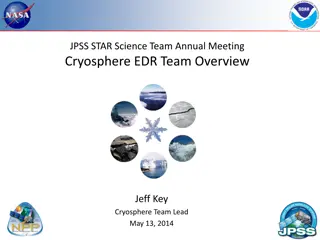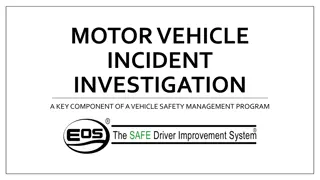Mission of EDR/DSSAD IWG for Vehicle Safety
The EDR/DSSAD IWG focuses on developing proposals for Event Data Recorders (EDR) and Data Storage Systems for Automated Driving (DSSAD) to enhance vehicle safety by recording essential data elements during safety-relevant events for conventional and automated vehicles.
Download Presentation

Please find below an Image/Link to download the presentation.
The content on the website is provided AS IS for your information and personal use only. It may not be sold, licensed, or shared on other websites without obtaining consent from the author.If you encounter any issues during the download, it is possible that the publisher has removed the file from their server.
You are allowed to download the files provided on this website for personal or commercial use, subject to the condition that they are used lawfully. All files are the property of their respective owners.
The content on the website is provided AS IS for your information and personal use only. It may not be sold, licensed, or shared on other websites without obtaining consent from the author.
E N D
Presentation Transcript
Fermentation An Old Profession Koji from rice by Aspergillus oryzae = 5,000 years Cheese by Penicillium roqueforti = 4,000 years Soy sauce in Asia = 3,000 years Bread in Egypt = 3,000 years (Hoelker et al., 2004)
Microbes: Masters of the Biosphere Life on earth is not possible without microbes They are the progenitors of all life on earth Characteristics: Rapid generation times Genetic flexibility Unequaled experimental scale Manageable study systems Estimate: 5x1031 microbial cells exist = 50 quadrillion metric tons Carry out more photosynthesis than green plants Over 90% of the cells in our bodies are microbial Sterile animals are less healthy then those colonized by microbes
PRIMARY METABOLITES Integral part of normal growth processes Building blocks for macromolecules Amino Acids Nucleotides Precursors of coenzymes Vitamins Precursors of lipids Fatty Acids Glycerol Precursors of polysaccharides Sugars Catabolic products Organic acids Ethanol Acetone Butanol
TITERS OF AMINO ACID PROCESSES L-lysine HCl L-glutamate 130 L-alanine L-valine 105 L-threonine L-proline 100 L-arginine L-serine 65 L-tryptophan L-tyrosine 55 L-phenylalanine L-glutamine 49 L-histidine L-hydroxyproline 41 L-isoleucine L-leucine 34 170 g/L 114 100 96 60 51 42 40
Organic Acids Pyruvic: 80 g/L at 2 g/Lh by recombinant Escherichia coli fed-batch Gluconic: 240 g/L with 99.4% yield by Penicillium variable; 50,000-60,000 tons, mainly by Aspergillus niger Fumaric: 107 g/L by Rhizopus arrhizus D-Lactic: 120 g/L by recombinant Corynebacterium glutamicum L(+) Lactic: 136g/L by Rhizopus oryzae Succinic: 146 g/L in 46h by recombinant C. glutamicum Malic: 113 g/L by Aspergillus flavus (Crognale et al., 2008; Engel et al., 2008, Okino et al., 2008; Zelle et al., 2008;Skory, 2004; Ge et al., 2004; Ding and Tan, 2006; Zhu et al., 2008)
SECONDARY METABOLITES ANTIBIOTICS ANTIBACTERIAL ANTIFUNGAL NON-ANTIBIOTIC INSECTICIDES ANTITUMOR AGENTS HERBICIDES ANTI-PARASITIC AGENTS PLANT-GROWTH REGULATORS PHARMACOLOGICAL AGENTS ENZYME INHIBITORS IMMUNOSUPPRESSANTS
NATURAL PRODUCTS 1 million total - 500,000-600,000 by plants - 50,000 by microbes 200,000-250,000 biologically active - 22,500 biologically active from microbes * 10,100 (45%) by actinomycetes * 8,600 (38%) by fungi * 3,800 (17%) by unicellular bacteria Berdy, 2005
ANTI-INFECTIVE MARKET IN 2000 Cephalosporins = $9.9 billion. Penicillins = $8.2 billion. Other -lactams = $1.5 billion. Antivirals excluding vaccines = $10.2 billion. Quinolones = $6.4 billion. Antifungals and antiparasitics = $4.2 billion. Aminoglycosides = $1.8 billion. Tetracyclines = $1.4 billion. Other antibacterials = $6.1 billion. Total = $55 billion. (M.S. Barber, 2001)
BENEFITS OF SECONDARY METABOLITES Average life expectancy in the USA increased from 47 years in 1900 to 74 years (males) and 80 years (females) in 2000. Reduced pain and suffering. Revolutionized medicine by facilitating organ transplantation. (Verdine, 1996; Lederberg, 2000)
ANTI-CANCER AGENTS SINCE 1940 >60%: Natural products, derivatives, or mimics Approved products Actinomycin D Anthracyclines (daunorubicin, doxorubicin, epirubicin, pirirubicin, valrubicin Glycopeptolides (bleomycin) Mitosanes (mitomycin C) Anthracenones (mithramycin, streptozotocin, pentostatin) Endiynes (calcheamycin) Taxol (Newman and Cragg, 2005)
METASTATIC TESTICULAR CANCER Uncommon (1% of male malignancies in USA; 80,000 in USA in 2000). Most common carcinoma in men aged 15- 35. Cure rates: 5% in 1974 90% in 2001 Combination chemotherapy: Bleomycin + etopside + cisplatin. (L.H. Einhorn, 2002)
Rapamycin Discovered as antifungal agent. Produced by Streptomyces hygroscopicus. Unusual nitrogen-containing triene macrolide (polyketide) with very large 31-membered lactone ring. Has antitumor activity. Immunosuppressive potency somewhat greater than FK-506 and 150X cyclosporin A. Toxicity less than cyclosporin A. Precursors: acetate, propionate, methionine, pipecolate, shikimate.
STATINS Produced by Aspergillus, Monascus, Penicillium, Doratomyces, Eupenicillium, Gymnoascus, Hypomyces, Paecilomyces, Phoma, Trichoderma, and Pleurotis. Uses Reduce risk of cardiovascular disease Prevent stroke Reduce development of peripheral vascular disease Antithrombotic Anti-inflammatory Lovastatin production by A. terreus = 7-8 g/L. Compactin production by P. citrinum = 5 g/L. Pravastatin can be made directly by certain strains of Aspergillus and Monascus. (Manzoni et al., 1998, 1999; Manzoni & Rollini, 2002)
Avermectin An Antiparasitic Agent Produced as a complex by S. avermitilis Antihelmintic agent and insecticide Disaccharide macrolides which do not inhibit protein synthesis but interfere with neurotransmission in invertebrates At least 10x more active than any synthetic Active against nematode and arthropod parasites in sheep, cattle, dogs, horses and swine
OMICS International www.omicsonline.org OMICS International (and its subsidiaries), is an Open Access publisher and international conference Organizer, which owns and operates peer-reviewed Clinical, Medical, Life Sciences, and Engineering & Technology journals and hosts scholarly conferences per year in the fields of clinical, medical, pharmaceutical, life sciences, business, engineering, and technology. Our journals have more than 3 million readers and our conferences bring together internationally renowned speakers and scientists to create exciting and memorable events, filled with lively interactive sessions and world- class exhibitions and poster presentations. Join us! OMICS International is always open to constructive feedback. We pride ourselves on our commitment to serving the Open Access community and are always hard at work to become better at what we do. We invite your concerns, questions, even complaints. Contact us at contact.omics@omicsonline.org. We will get back to you in 24-48 hours. Contact us at: contact.omics@omicsonline.org You may also call 1-800-216-6499 (USA Toll Free) or at +1-650-268-9744 and we will return your call in the same timeframe.
Journal of Microbial & Biochemical Technology: Open Access Related Journals Journal of Chemical Engineering & Process Technology Journal of Biotechnology & Biomaterials Journal of Bioremediation & Biodegradation Journal of Bacteriology & Parasitology Journal of Medical Microbiology & Diagnosis
Journal of Microbial & Biochemical Technology: Open Access Related Conferences 3rdInternational Conference on Clinical Microbiology & Microbial Genomics
OMICS Group Open Access Membership Open Access Membership OMICS publishing Group Open Access Membership enables academic and research institutions, funders and corporations to actively encourage open access in scholarly communication and the dissemination of research published by their authors. For more details and benefits, click on the link below: http://omicsonline.org/membership.php
